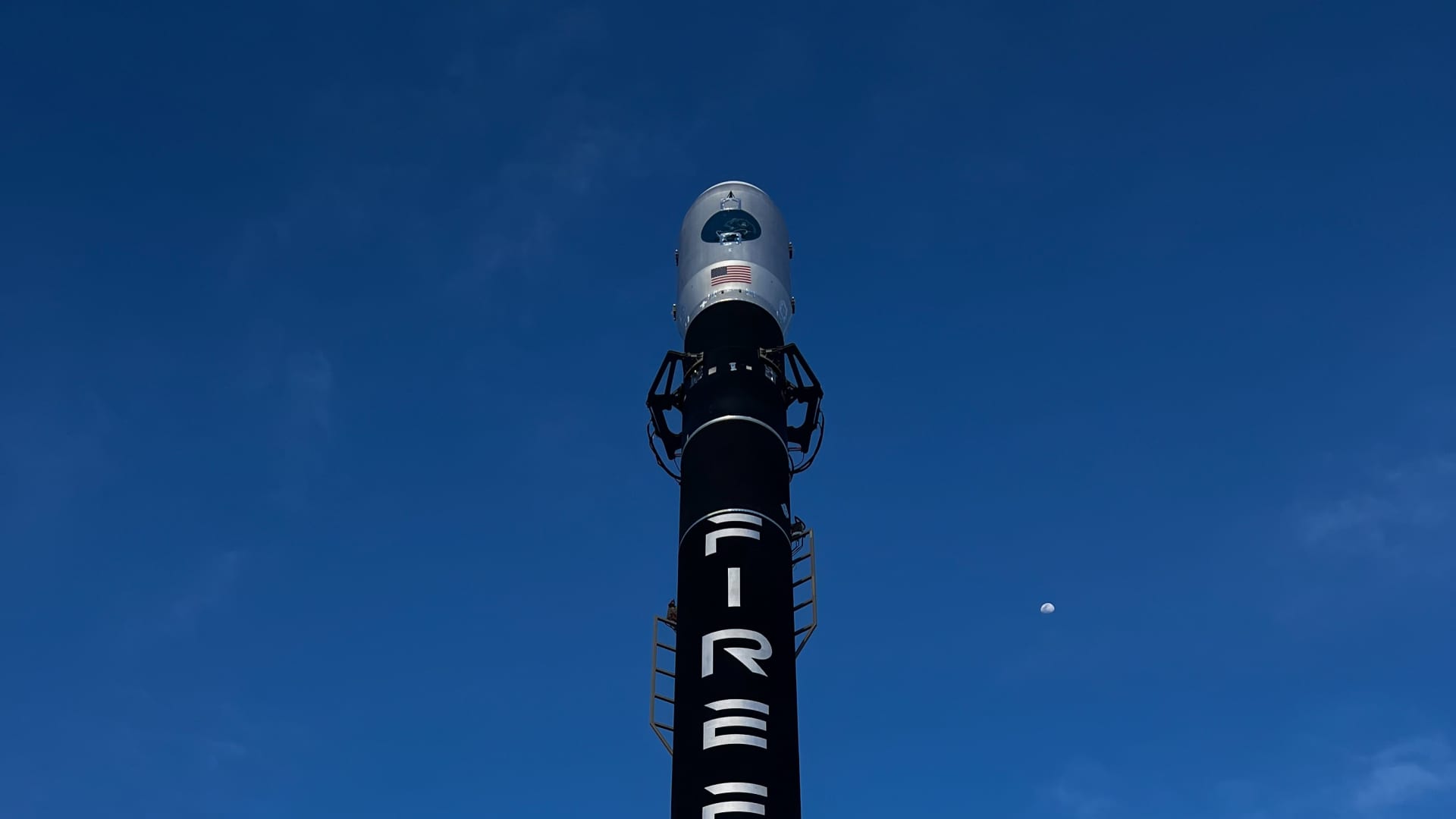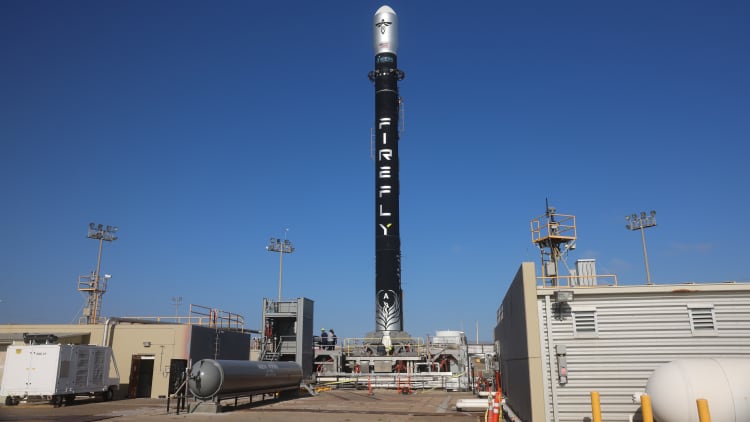
The Alpha rocket for the Space Force’s Victus Nox mission stands on the launchpad at Vandenberg Space Force Base, California.
Firefly Aerospace
The name says it all: Victus Nox, or, translated from Latin, “conquer the night.”
It’s an experimental test run of national security capabilities in space, and a high-stakes mission for a pair of burgeoning space companies — a crucial chance to prove they can handle the high-speed demands of the U.S. Space Force.
The mission for the military’s Los Angeles-based Space Safari team calls for flying a Millennium Space Systems-built satellite on Firefly Aerospace’s Alpha rocket — on remarkably short notice. For Boeing subsidiary Millennium the mission will be just the 14th satellite it’s flown to date, and for Firefly it’s only the third launch of its rocket.
The challenge of this mission lies in its unique requirements for the companies, Lt. Col. MacKenzie Birchenough, leader of the Tactically Responsive Space program within Space Safari, explained to CNBC.
“They don’t know when they’re going to get the call to launch,” she said. “From their perspective, the things that normally happen over weeks or months are now crunched down to basically minutes and days.”
Sign up here to receive weekly editions of CNBC’s Investing in Space newsletter.
Birchenough and the Tactically Responsive Space, or TacRS, program aim to work with spacecraft and rocket builders to create “the capability to quickly respond to on-orbit needs” on “very short timelines.”
Space Force is keen to continue pushing the limits of satellites and rockets with more TacRS missions, with its most recent budget request outlining $60 million over the next two years for the program.
Victus Nox is a “space domain awareness mission,” Birchenough said, which effectively means it’s a satellite intended to track other objects in orbit, as well as predict possible space threats.
“This whole mission is based off what a real-world situation would be like, and making sure that this operational demo is as close to that as we can possibly get,” she said.
The Alpha rocket for the Space Force’s Victus Nox mission stands on the launchpad at Vandenberg Space Force Base, California.
Firefly Aerospace
Firefly CEO Bill Weber acknowledged that, while the space domain is becoming increasingly privatized, “it’s not enough to truly call the commercialization of space ‘responsive.'”
“We don’t have that ability right now for anything other than weapon systems. In space, we do not have the ability within a near-term time frame to respond” to a national security threat or crisis, Weber said.
Space Force selected Firefly and Millennium for the Victus Nox contract in October, setting off a chain of events starting with the build phase. Firefly’s contract for the mission is worth $17.6 million, while Millennium’s contract value was not disclosed.
Next up is the “hot standby” phase, in which Millennium waits to receive a 60-hour window to get the spacecraft from Los Angeles to the launch site at Vandenberg Space Force Base in California. Then the mission initiates an on-call phase, where the teams are on standby, and finally a launch phase, when Space Force gives the companies 24 hours to get the rocket and satellite off the ground.
Space Safari aims to build upon the success of its most recent responsive demo mission, which flew in June 2021, as well as use the TacRS program to leverage and test more companies.
Birchenough said Space Safari sees this program as a “crawl-walk-run approach,” with initial planning for the next mission underway.
“We’re pushing the limits here and taking some risks,” she added.
Firefly’s opportunity

Firefly originally planned to fly a NASA mission on its third Alpha rocket launch, after the company reached space with its second launch in October. And then Space Safari came knocking, and Weber said his company had enough “flexibility” on the timing of the NASA mission to swap it out for Victus Nox.
Standing at 95 feet tall, Firefly’s Alpha rocket is designed to launch as much as 1,300 kilograms of payload to orbit — at a price of $15 million per launch. That puts Firefly in the medium-lift category of rockets, between small launchers such as Rocket Lab’s Electron and the “heavy” rockets such as SpaceX’s Falcon 9.
Firefly completed a “full-duration static fire” of the Alpha rocket at Vandenberg, and the company is now going through final readiness steps. Victus Nox represents a distinct opportunity for Firefly, both to prove it’s ready to fly national security missions as well to use the launch to streamline its processes and move faster.
“Firefly emerges from this mission set ready to go at a much quicker pace,” Weber said. “When Victus Nox launches, our intention is to go two months after that and on in succession. Alpha will be that predictable schedule, of a one metric ton rocket [flying] every two months.”
Weber said the company currently has customer commitments for seven more flights on Alpha after Victus Nox.
Millennium’s momentum
The Victus Nox satellite undergoes modification work.
Millennium Space
According to Millennium CEO Jason Kim, the Space Safari team came to the company’s production line and said, “Hey, I want one of those spacecraft.”
“The idea there is if you take something that’s off the production line, you don’t have to start from scratch to rapidly deploy a tactically responsive space capability to meet an urgent need or augment capabilities that are already on orbit,” Kim said.
Kim said Millennium modified the Victus Nox satellite in eight months, a significantly shorter timeline than the typical 24- to 36-month process of starting an order from scratch.
The Boeing subsidiary is “very focused” on the national security side of the space market, Kim said, with Victus Nox coming as its latest project to deliver spacecraft “affordably on rapid timelines.”
Millennium has heavily prioritized vertical integration, which Kim said helps the company “control the cost, the schedule and the quality of those components” in the spacecraft it builds.
“We’re learning so much from [Victus Nox], and the Space Force is learning a lot from it,” Kim said.
Once Space Force issues the call to launch, Kim said his team will work with Firefly to fuel and process the spacecraft and integrate it on the rocket. Once the spacecraft is in orbit, Millennium will check it within 48 hours to show it’s working properly and ready for operations.
“It’s this team, this collective team — the Space Force, Millennium Space Systems, Firefly — against the threats, we don’t see it against each other,” said Kim. “We all have a common purpose. And I think that’s gone a long way to the success that we’re showing.”






